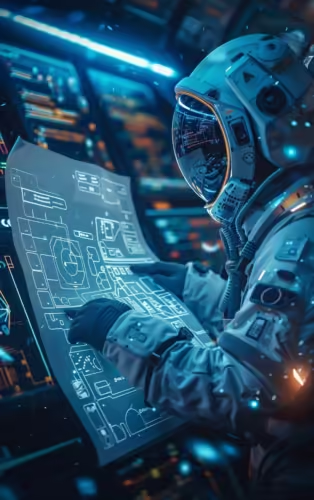Are you curious about what goes on behind the scenes of space exploration? The European Space Agency’s (ESA) missions to the International Space Station (ISS) offer an incredible perspective on humanity’s endeavors beyond Earth. These missions, documented extensively through blogs, provide valuable insights into the lives and work of astronauts, groundbreaking scientific endeavors, and the management of the space environment.
From the unique experiences of ESA astronauts aboard the ISS to the transformative space missions like Rosetta and Mars Express, the ESA Blog Navigator serves as a rich resource. It’s not just about exploration, but also the importance of initiatives such as ESA’s clean space program and open access policies. These blogs weave a tapestry of science, discovery, and responsibility in space exploration.

Table of Contents
ESA’s Historical Context and Mission
The European Space Agency has been instrumental in advancing space exploration since its inception in 1975. With member countries across Europe, ESA has consistently focused on expanding our understanding of space and broadening the horizons of science and technology on an international scale. Among its many contributions, ESA’s partnership in the International Space Station serves as a testament to international cooperation in space research.
The Formation and Purpose of ESA
Understanding ESA’s foundation involves recognizing a unifying purpose: harnessing the collective scientific strength of European nations to explore space. Founded from the amalgamation of ELDO (European Launcher Development Organization) and ESRO (European Space Research Organization), ESA aimed to accomplish more in collaboration than could be achieved separately.
The Role of ESA in International Collaboration
ESA’s collaboration with NASA and other space agencies highlights the importance of shared goals in space exploration. By facilitating an exchange of knowledge and resources, the ISS stands as a symbol of what humanity can accomplish together. This collaboration extends beyond missions; it encompasses continuous learning and development in astronaut training, technological advancement, and international policy-making in space affairs.
The Latest Trends in Space Missions
Current trends in space missions reflect a growing emphasis on sustainability, data accessibility, and the advancement of science through international partnerships. These trends are captured in various blog posts that document ESA’s strategic focus and practical steps.
Progress in Clean Space Initiatives
ESA’s clean space initiatives represent the growing global awareness of space debris and its long-term implications. The clean space program is pivotal in advancing sustainable mission practices, ensuring that as humanity reaches farther into space, we do so responsibly.
Open Access Policies at ESA
Another significant trend is ESA’s commitment to open access policies. By making data more accessible to researchers and the public, ESA enhances the transparency and utility of its scientific missions. This approach not only democratizes knowledge but also encourages a broader scope of scientific inquiry and innovation.
Key Missions Highlighted by ESA
Several key missions are frequently discussed in ESA’s blogs, each contributing uniquely to space exploration and science.
Rosetta: A Milestone in Cometary Study
The Rosetta mission symbolizes a historic achievement—a detailed study of a comet up close. Launched in 2004, Rosetta traveled over a decade to reach comet 67P/Churyumov-Gerasimenko. Its findings have reshaped our understanding of comets and the early solar system, offering priceless data for future research.
Mars Express: Probing the Red Planet
Mars Express, launched in 2003, continues to be a cornerstone for Martian exploration. Its orbital instruments collect high-resolution images and analyze Martian geology and atmosphere, enabling discoveries about water presence, atmospheric composition, and potential habitability.
The Life of ESA Astronauts on the ISS
Life aboard the ISS is vastly different from life on Earth. ESA astronauts provide firsthand accounts of their missions through engaging blogs, sharing their unique experiences and contributions to space exploration.
Daily Routines and Research
Astronauts’ blogs often delve into their daily routines, emphasizing the rigorous schedules that include scientific research, exercise, and maintenance work. Such accounts offer readers a tangible sense of the discipline and dedication required to live and work in microgravity.
Scientific Experiments and Their Impact
One of the critical responsibilities of ESA astronauts involves conducting experiments that would be impossible on Earth. These range from studying fluid dynamics in microgravity to examining plant growth in space, each contributing valuable data for scientific advancement and practical applications back home.

Diverse Perspectives on ESA’s Missions
A balanced understanding of ESA’s missions comes from analyzing a range of perspectives, depicted in various blog posts detailing challenges, triumphs, and ongoing exploration questions.
Perspectives from ESA Scientists
Scientists offer insights into the technical and scientific hurdles of each mission, discussing pre-launch preparations, post-mission discoveries, and how findings spur new lines of inquiry. These discussions highlight the intricate work of translating mission objectives into achieved outcomes.
Contributions from Partner Agencies
Insights from partner agencies accentuate the collaborative nature of space missions. By sharing resources, knowledge, and expertise, these partnerships fuel greater accomplishments, reflected in both mission successes and advanced research outputs.
Impact and Implications of ESA’s Missions
The impact of ESA’s missions extends well beyond academic and scientific circles, influencing societal, environmental, and future exploration efforts.
Societal and Educational Impact
ESA’s missions inspire not only budding scientists and engineers but also bring space studies into schools worldwide, fostering a new generation’s interest and capabilities in science and technology. Educational partnerships and outreach initiatives amplify this effect.
Environmental Awareness and Advocacy
Through its clean space initiatives, ESA underscores the importance of responsible exploration. By addressing space debris and environmental impacts, ESA sets a precedent for future missions to prioritize sustainability.

Future Directions and Potential Developments
Considering future directions involves looking at ESA’s plans for upcoming missions, technological innovations, and how these may shape space exploration’s future.
Predictions for Future ESA Missions
Future missions seek to deepen knowledge of our solar system and beyond, with focus areas including lunar exploration, deep space ventures, and augmented Earth observation capabilities. These missions promise to enhance our comprehension of space phenomena and their terrestrial implications.
Implications of Continued Space Exploration
Continued exploration will likely transform numerous industries, from telecommunications and Earth sciences to materials engineering and environmental management. The insights gained can lead to technological breakthroughs that permeate everyday life, driving progress and fostering a deeper understanding of our universe.
Conclusion: Reflecting on ESA’s Expedition
In essence, ESA’s commitment to exploration, sustainability, and collaboration continues to push the boundaries of human knowledge and capability. By leveraging international partnerships and promoting scientific inclusivity, ESA sets a model for future missions.
Space exploration, guided by agencies like ESA, is not just a quest for knowledge but a bridge to a future where understanding transcends Earthly boundaries. Considering this journey, how might the achievements of ESA influence your perspective on space exploration and its potential impacts on our global community?


